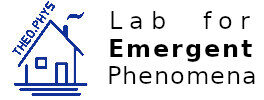Bachelor thesis – Max Hörmann
Max Hörmann
Dynamical correlations of disordered one-dimensional quantum antiferromagnets
finished 2017-08
supervised by Kai Schmidt
Abstract
A general framework for calculating the zero-temperature dynamic structure factor of the dimerized spin-1/2 chain and the Heisenberg spin-1/2 two-leg ladder in the presence of disorder is given. For that the methods of perturbative continu- ous unitary transformations and white graph expansions about the limit of isolated dimers are applied to derive the physical properties of the elementary triplon ex- citations. This way numerical high-precision results are obtained for large finite systems if the strength of the perturbation lies within the convergence radius of the perturbative expansion. All sorts of disorder can be treated within the frame- work. Apart from dynamical correlations of inelastic neutron scattering observables also the density of states and the inverse participation ratio is calculated. One- and two-triplon properties are investigated. Not only one- but also two-triplon states are found to be localized in the sense that almost all the weight of their eigenfunctions sits on a finite number of position states. The mean of the absolute squared one-triplon effective Hamiltonian in momentum space is derived analyt- ically. Its values are used to calculate the self-energy within the self-consistent Born approximation for rung disorder and within the Born approximation for leg disorder. Various bimodal leg and rung disorder configurations are compared nu- merically and show the same qualitative behaviour of lifetimes as expected by the former theoretical results. While for the Lorentzian convolved dynamic structure factor Gaussian disorder on the leg shows similar features as bimodal disorder for Gaussian rung disorder the dynamic structure factor is very different especially for two-triplon weights. The density of states of bimodal rung disorder and also of strong enough bimodal leg disorder configurations is found to not converge to a smooth distribution in the one-triplon sector. In contrast to that Gaussian disorder always shows a smooth density of states. Sharp two-triplon bound states are found to get a finite lifetime but can still be separated as peaks from the continuum for some sorts of disorder. The dynamic structure factor calculations model material classes like BPCBx C1−x . Quantitatively trustful calculations with the couplings of that material have been performed and it is found that two-triplon bound states might survive not to big concentrations of bromine atoms.
A general framework for calculating the zero-temperature dynamic structure factor of the dimerized spin-1/2 chain and the Heisenberg spin-1/2 two-leg ladder in the presence of disorder is given. For that the methods of perturbative continu- ous unitary transformations and white graph expansions about the limit of isolated dimers are applied to derive the physical properties of the elementary triplon ex- citations. This way numerical high-precision results are obtained for large finite systems if the strength of the perturbation lies within the convergence radius of the perturbative expansion. All sorts of disorder can be treated within the frame- work. Apart from dynamical correlations of inelastic neutron scattering observables also the density of states and the inverse participation ratio is calculated. One- and two-triplon properties are investigated. Not only one- but also two-triplon states are found to be localized in the sense that almost all the weight of their eigenfunctions sits on a finite number of position states. The mean of the absolute squared one-triplon effective Hamiltonian in momentum space is derived analyt- ically. Its values are used to calculate the self-energy within the self-consistent Born approximation for rung disorder and within the Born approximation for leg disorder. Various bimodal leg and rung disorder configurations are compared nu- merically and show the same qualitative behaviour of lifetimes as expected by the former theoretical results. While for the Lorentzian convolved dynamic structure factor Gaussian disorder on the leg shows similar features as bimodal disorder for Gaussian rung disorder the dynamic structure factor is very different especially for two-triplon weights. The density of states of bimodal rung disorder and also of strong enough bimodal leg disorder configurations is found to not converge to a smooth distribution in the one-triplon sector. In contrast to that Gaussian disorder always shows a smooth density of states. Sharp two-triplon bound states are found to get a finite lifetime but can still be separated as peaks from the continuum for some sorts of disorder. The dynamic structure factor calculations model material classes like BPCBx C1−x . Quantitatively trustful calculations with the couplings of that material have been performed and it is found that two-triplon bound states might survive not to big concentrations of bromine atoms.
